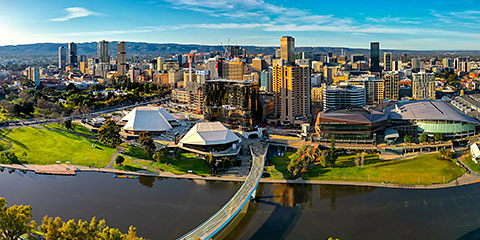Locale » About Adelaide
 City of Adelaide
City of AdelaideThe City of Adelaide acknowledges the Kaurna people as the Traditional Owners of the Country where the city of Adelaide is situated today, and pays its respect to Elders past and present.
Kaurna Heritage
The Adelaide Plains are the traditional lands of the Kaurna people, stretching from Port Broughton down to Cape Jervis. Kaurna actively manage the land and live off the land and waterways of the region. Kaurna is the language spoken, and as you move around the city today, you'll see it used in many ways. The main square in the heart of the city is known as Victoria Square/Tarntanyangga, reflecting the Kaurna name for the area - Tarntanyangga - which means Red kangaroo dreaming. Similarly, the river is named River Torrens/Karrawirra Parri, reflecting the Kaurna name meaning Redgum forest. All 29 parks and significant heritage sites across the city and Park Lands have been assigned a Kaurna name.
Kaurna Art and Culture
In addition to Kaurna, other First Nations language groups are represented in art and culture and are widely celebrated throughout Adelaide. A great way to discover it is through the Adelaide Kaurna Walking Trail*. Another example of Kaurna art is The Riverbank is a Kaurna Marketplace, by Kaurna Artist Paul Herzich and built in 2018. The artwork consists of a series of sandblasted images along Topham Mall. Drawn from Kaurna culture this installation allows people to walk in the ancient footsteps of the Kaurna people between the river to the market.
Adelaide, also known as the "City of Churches", is the fifth-largest city in Australia and the capital city of South Australia. With its charming blend of modernity and heritage, Adelaide has become a thriving hub for food, wine, arts, and festivals. Whether you're a history buff, a nature lover, or a foodie, Adelaide has something for everyone. From the picturesque Adelaide Hills to the bustling Central Market, this city is full of hidden gems waiting to be discovered.
Adelaide Was A Free Settlement
Adelaide is the only capital city in Australia that was not settled by convicts, which has made the locals extremely smug. Established in 1836, the city was a planned capital for free British settlers. Most of the people had no criminal history, the city was thought to have little crime compared to other areas. As a result, no prison was built for some time. Criminals took advantage of this decreased law enforcement and a prison was added soon after.
The 20-Minute City
Adelaide is a small city, but did you know it only takes 20 minutes to get to any point in the city? Nicknamed the 20-minute city, Adelaide is one of the easiest cities to venture around. Test out the theory for yourself!
City of Churches
Adelaide has many nicknames, including the city of churches. You'll see a church on every corner. Some are historic monuments where some are simply a few years old.
Home to the Biggest Display of Aboriginal Artefacts
Adelaide is home to the largest display of Aboriginal artefacts. You can see this huge range on display at the South Australia Museum.
The Opal City
Adelaide is the opal capital of Australia, famous both locally and internationally for the best-selling opals available.
Has the Third Most Expensive Building
The city's recent construction of the Royal Adelaide Hospital has cost a whopping 2.7 billion Australian dollars. This makes it the third most expensive building in the entire world. The hospital also broke the record for being the largest building ever built in Australia.
The City of Firsts
Throughout history, Adelaide has been at the center of forward thinking. It was the first city to give women access to vote, recognize Indigenous land rights, as well as criminalize sexual and racial discrimination.
Source: adelaidecitytour.com.au/blog/interesting-facts-you-might-not-know-about-adelaide/